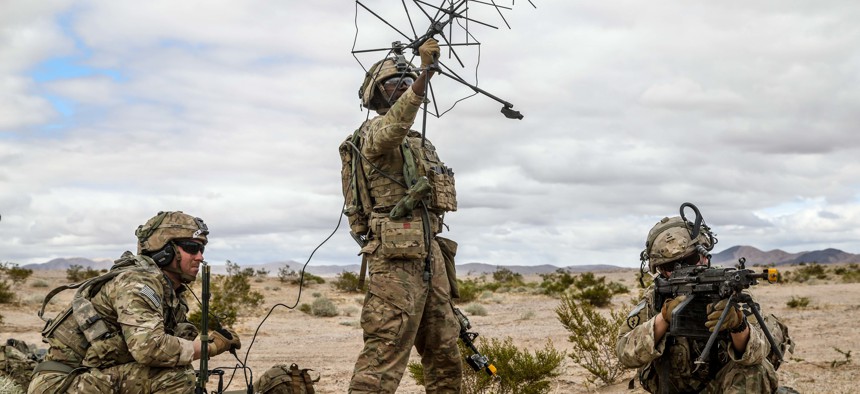The Army is putting all its network efforts under one roof

2nd Infantry Division soldiers use satellite communication systems at the National Training Center at Fort Irwin, California, on March 10, 2020. U.S. Army / Pfc. Rosio Najera
By October, Program Executive Office Command, Control, Communications-Tactical is expected to absorb network portfolios from its sister PEO for enterprise services.
The Army’s shop in charge of battlefield communications will soon handle all of the service’s network development and purchasing, according to a defense official.
The service’s acquisitions chief decided that “all network communications needs to be under one PEO. and so it is going to be under this PEO,” Maj. Gen. Anthony Potts, the chief of Program Executive Office Command, Control, Communications-Tactical, said Wednesday during a keynote at the 2023 Satellite conference in Washington, D.C. “Everything that resides in the [Program Executive Office Enterprise Information Systems] that is network will come to us—and yes, we will have to change our name.”
A new name hasn’t been chosen yet, but the plan is to absorb all of PEO EIS’ network-related programs by Oct. 1, including the integrated enterprise network program, global enterprise network modernization programs in the U.S. and abroad, base emergency communications system, and wideband enterprise satellite systems.
The move aims to streamline how the Army manages network integration, materiel development and acquisition since enterprise and tactical networks are no longer separate, said Paul Meheny, an Army spokesperson. The shift is also part of the implementation plan for the Army’s 2021 unified network strategy.
In other news, PEO C3T is also planning a satellite-as-a-managed-service pilot program this summer to see whether that kind of model can meet the Army’s capability, doctrine, and other needs.
“What's important to me about the SAAMS pilot is not the level of capability that we're going to provide to somebody through that pilot…I care about what we learn,” Potts said. “This is about scalability. If we get into some of these large-scale conflicts, and we only have so much stuff, how do you help us scale to this idea of satellite as a managed service?”
Potts said the pilot won’t upend the Army’s current satellite programs but will be part of a “hybrid approach” to provide “a base capability that we're not depending on anybody else to provide us.”
The Army has been working to solve data, communications, and network challenges, particularly in the Indo-Pacific region.
In addition to the satellite pilot, the Army is testing out a logistics dashboard this week as part of its cloud-based Command Post Computing Environment.
“They'll be able to see where everything is moving that's got their cargo on it, and they'll be able to click on it and tell you exactly what's in that ship or on that plane,” Potts said.
He said the display will also use artificial intelligence for predictive analysis.
The goal is to move beyond sending messages and searching for information that could be buried in calendar entries or email attachments, what’s often referred to as unstructured data.
“It starts with: I've got a master set of data, and I know how to get to that master set of data,” and the network to send it, Potts said. “I have to have the transport capability and it must be agnostic and it must be available. It is absolutely fundamental to the construct of a data centric fighting force.”
NEXT STORY: The Marines are launching a software factory






